Mindset Cards are a tool for building, transforming, and assessing culture in groups. They help us create a language to talk about mindsets and values. They make it safer and easier to have concrete, productive, courageous conversations about things that are important to discuss but that can often feel vague and ungrounded.
You can use them with groups of any size — from two people to hundreds, even thousands — and types — from small teams to large organizations, even your family and friends. They’re ideal for:
- Defining and assessing organizational culture
- Defining and assessing team working agreements
- Working through difficult group dynamics
You can also use them individually for your own personal development.
Mindsets
We often behave the way we do because of what we think (mindsets) and believe (values). However, these are invisible, so unless we share these explicitly with each other, we have to guess to understand why people behave the way they behave.

In order to do that, we have to invent language to describe our mindsets and values, and we have to tell stories to understand their meaning.
These mindsets were originally harvested from work that Eugene Eric Kim, Kristin Cobble, and Rebecca Petzel did together over several years at Groupaya working with organizations on culture change. We iterate these mindsets on an ongoing basis through testing and feedback.
Instructions
(You can download a printable version of these instructions.)
The Basics
All of the methods described below are variations of the following:
- Pick a group or project you’re working with. Context matters.
- Rapidly go through the deck, and pull out cards that resonate for whatever reason.
- Choose one of the cards that you pulled that represents a productive mindset — a mindset that you’d like to see the group exhibit more of.
- Show this card to someone else in the group. Explain why you chose it. Tell specific stories if you can.
- Take turns and / or repeat as often as you’d like.
Mindset Spectrums
The language on each mindset card helps us get more precise about the kind of culture we want and don’t want. However, there is still a lot of gray area. You can get even more precise by creating mindset spectrums, which allows you to talk more concretely about not just what is desired, but how much.
This works best with one or two people. You can do it with more than two, but it’s better to use the Divide and Converge approach for that described below.
- Follow steps 1-4 of The Basics described above. Instead of choosing one card representing a productive mindset you’d like to see the group exhibit, choose three.
- For each productive mindset, go through the deck and pull out the counter less productive mindset. If you can’t find the card you want, fill in one of the blank cards. Create a spectrum by putting the less productive mindset on the left and the more productive mindset on the right:
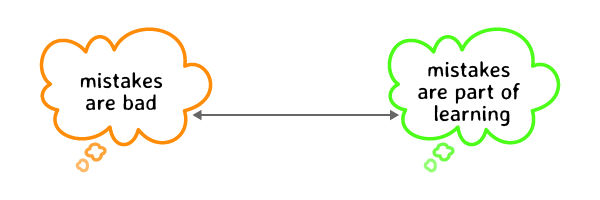
- Take a moment to think about where along this spectrum you’d like the GROUP to be. When everyone has an answer, have everyone mark their spot. You can mark a piece of paper, use a physical marker, or physically form a giant spectrum and move your bodies to represent your position. For example:
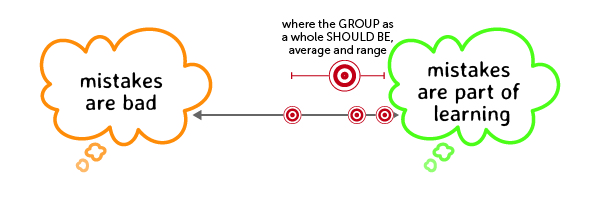
Discuss. Start with the outliers. Why did people pick their spots? This is not about persuading others, but about understanding each other’s thinking. However, if people feel compelled to move their marks as their hear others speak, they can. The average of where people put their marks acts as the collective aspiration. - Now take a moment to think about where along this spectrum YOU are right now. When everyone has an answer, have everyone mark their spot. For example:

Discuss. Start with the outliers. Why did people put their marker there? The average of people’s marks acts as the assessment for where the group is right now.
One variation of this exercise is to examine the tension between two productive mindsets that might potentially come into conflict. The exercise works the same way, except the aspiration will likely be more in the middle of the spectrum than toward the right.
If your assessment is at or beyond your aspiration, then you’re already doing well! It’s useful to be able to articulate what you’re already doing well, not just what you have to work on, because it represents a culture that already exists, which is helpful both as a reminder and also for new people who join the group.
If your assessment is below your aspiration, brainstorm with your group experiments for closing that gap. Keep in mind that mindset shift is hard, that it takes time, and that you’ll fail a lot more than you’ll succeed. You can repeat the assessment process to track your progress.
Note that self-assessments are not scientific. Treat these as an opportunity to talk with each other about important, sometimes difficult topics and to get aligned about where you are and where you want to go.
Start, Stop, Continue
This is an alternative to Mindset Spectrums. This works best with one or two people. You can do it with more than two, but it’s better to use the Divide and Converge approach for that described below.
- Follow steps 1-4 of The Basics described above. Instead of choosing one card representing a productive mindset you’d like to see the group exhibit, create three piles of cards: Mindsets you’d like to Start having, mindsets you’d like to Stop having, and mindsets you’d like to Continue having.
- Prune each pile so that there are only 3 cards in each.
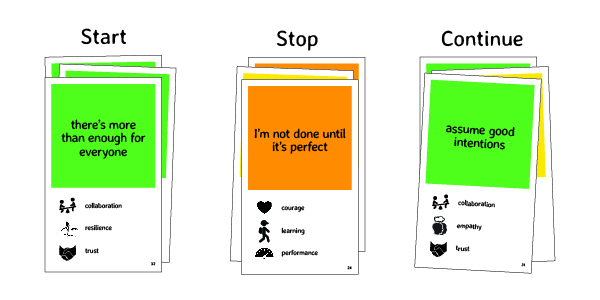
- Show your piles to someone else in the group. Explain why you chose these cards. Tell specific stories if you can.
If you’re playing individually, you can cycle through your cards each day as a reminder of your intentions.
Divide and Converge
With both Start, Stop, and Continue and Mindset Spectrums, you’re ultimately trying to get to a handful of cards per pile or spectrums — 3-5 at most. For one or two people, this is a fairly straightforward prioritization process. For more than two, it can get complicated quickly.
Rather than try to prioritize as a whole group, we’d encourage you to do it as small groups, then come together.
- Divide up the group into pairs, and have each pair play Start, Stop, and Continue or Mindset Spectrums.
- Pair up the pairs, have people discuss the cards they chose, and — as a larger group — try to agree on three cards per pile or three spectrums.
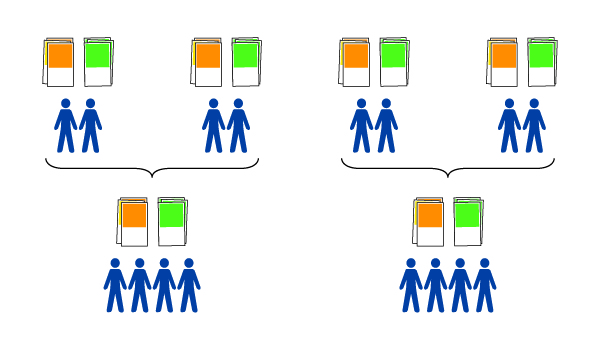
- Continue re-combining groups and repeat until the whole group is together once again.

This process can scale to literally thousands of people. To help you track the cards being chosen, you can use the index number on the bottom-right of each card.
The Others
It’s human to form tribes or factions. There are lots of good things that can come out of this, but it can also result in divisiveness and silos.
You can use this technique with either Start, Stop, and Continue or Mindset Spectrums to build greater unity and empathy. You could use this for:
- A leadership team and the people who report to them
- Different teams within larger organization working together
- Different groups within a multi-stakeholder collaboration
It’s especially useful when there are complicated power dynamics.
- Divide into groups.
- Have each group play either Start, Stop, and Continue or Mindset Spectrums both for themselves and for the other groups. (Use Divide and Conquer if the groups are large.) In other words, if you’re doing this with three different teams working together, each group would have three sets of piles or spectrums: One for themselves, and one for each of the other two groups.
- Share the piles or spectrums with each other. Why did you choose these? What are the similarities and differences between the cards you chose for yourself versus the cards others chose for you?
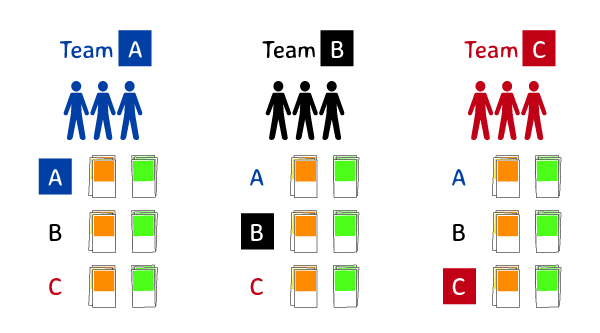
Based on these discussions, have each group decide on the piles or spectrums they will be committing to.
Values
If your group has already agreed on a set of core values, you can use these values to prune your deck and simplify any of the mindset exercises described above. Go through the deck, and take out every card that lists one of your values (or something similar).
Alternatively, if your group has not already agreed on a core set of values, you can do one of the mindset exercises above (either Start, Stop, and Continue or Mindset Spectrums), examine the cards you’ve chosen, and use the values listed there as a candidate list of values for your group.
Your Ideas!
There is no wrong way to use these cards! Practice and play.
Please share how you’re using them at diy-strategy-culture@nullfasterthan20.com!
Related Toolkits
These Mindset Cards are part of a larger DIY Strategy / Culture toolkit, which also includes:
- Working Agreements. Helps you agree on how your group will work together.
- Goals / Success Spectrum. Helps you get very clear and aligned about vision, strategic goals, and success metric.
- Strategy / Culture Bicycle. Surface, align around, and prioritize critical questions about strategy and culture.
- Roadmap. Explore different scenarios and develop a strategic plan.
For more on the design philosophy of these tools, read, “Balance Bikes for Changemakers” (January 16, 2018).
See Also
Credits
These cards were created by Eugene Eric Kim and Amy Wu with considerable contributions from Rebecca Petzel and Kristin Cobble.
Kristin Cobble first introduced the mindset framework to Eugene in 2010, and it formed the basis of several of the projects they did together with Rebecca Petzel at Groupaya. Eugene conceived of these cards as a way to make this work more accessible to others. In 2014, he did an initial harvest with Rebecca and created the first versions of these cards. Soon thereafter, he partnered with Amy to take these cards to the next level.
We are indebted to the Garfield Foundation, which supported much of Eugene’s early efforts with these cards, and to the many people who have contributed ideas and feedback and who have prototyped these cards. They include:
| Marla Cornelius Kavi Harshawat Kim Howard Wendy Fong Diane Johnson Phil Martin |
Rick Reed Ruth Rominger Dharmishta Rood Giselle Sperber Aerjen Tamminga Alex Tran |
This work is public domain.
History
July 23, 2018
- New box and printed instructions
February 7, 2016
- Added ID number and version to the cards
- Consolidated different values variations into one standard deck
May 4, 2015
- Released as part of v1.0 of DIY Strategy / Culture toolkit